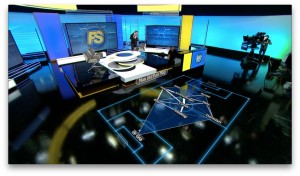SVG Europe Sit-Down: Ericsson’s Steve Plunkett and Vincent Noyer discuss 5G and the way forward for the graphics portfolio

Ericsson has carried out development work to provide additional content, such as sports data and analysis, during live events
Ericsson is, of course, a multi-faceted company, and within that company the broadcast and media services provide an equally diverse range of facilities. These include online video services, media management, playout and graphics – to name but a few. Therefore, to cover a range of topics and introduce a breadth of experience, our conversation involved both Steve Plunkett, CTO, Broadcast and Media Services and Vincent Noyer, Head of PIERO Sport Graphics, Broadcast and Media Services. We started with a recent significant event…
What does the introduction of your 5G milestone mean for sports broadcasting?
Plunkett: 5G introduces new levels of capacity and performance that will be of particular benefit to both sports broadcasters and their audiences. Highlights include greater cell density and bandwidth, much higher bitrates to each device and very low latency. These improvements will make 5G a great choice for contribution links at sports venues and support new audience experiences that demand high bandwidth and low latency such as VR.
What do you see as the biggest challenges you face today?
Plunkett: There are several challenges that face our media customers. First of all, how do you address viewers’ constantly changing tastes and viewing habits, especially as media consumption increasingly moves to mobile, on-demand consumption continues to grow and more and more market disruptors challenge established players. The key is to be agile and fast in launching new services or discontinuing unsuccessful ones. Secondly, it’s now more important than ever before for media companies to keep track of emerging new technologies, content types and consider how they can be used to attract, retain, and engage viewers. AR and VR, for example, have huge potential to expand the TV experience, but are still some way away from maturity. Another challenge is the changes in monetisation models. With the shift of ad spend from traditional TV to digital and mobile and viewers’ decreasing tolerance to advertising that interrupts their experience, it will be interesting to see which monetisation models succeed.
Where do you see second screen applications going over the next 12 to 18 months?
Plunkett: Second screen started as a disjointed past time for multitasking viewers or as an alternative to the traditional TV screen. What we will see in the future is the two screens complementing each other to create a more engaging and immersive experience. For example, a lot of development has been done to provide additional content, such as sports data and analysis, during live events. This can improve user experience and bring back attention. We are experimenting with Microsoft HoloLens to bring insight into the game without disrupting the main screen.
Thinking of your PIERO portfolio – what do you see as the greatest innovation in sports graphics in recent times?
Noyer: The greatest innovation for sports fans in recent years is the convergence of video formats towards higher resolutions and progressive fields. It provides improvement across the board for slicker graphics.
On the same theme – where next for Augmented Reality?
Noyer: The PIERO Augmented Reality solution was developed as an evolution of our data visualisation capabilities. As the product matures we are able to expand the effects and sports supported by AR. We want to offer TV sport productions the choice between analysis through traditional full screen clips or AR without compromising on the speed of execution.
But what do you see as the next innovation when it comes to IP technology?
Plunkett: The displacement and replacement of SDI in many broadcast facilities is picking up pace. The relatively early adoption of UHD in sports broadcasting has been a key driver of IP adoption with Quad 3G-SDI proving cumbersome and expensive. The initial approach of encapsulating the entire SDI payload over IP (SMPTE 2022:6) is evolving towards a more flexible decoupling of the audio, video and data elements and this year will see initial traction of the SMPTE 2110 series of standards to support that. This will support more flexible live sports workflows in the future.
What is your prediction when it comes to the growth of On Demand services – and how will Ericsson service that branch of the industry?
Plunkett: We see continued growth in on-demand viewing, particularly on mobile devices. This is driven by a combination of improved display capabilities on modern smartphones – including higher resolution, larger average screen size and higher frame rate support, faster and more affordable network bandwidth in many markets, and greatly expanded access to premium content from traditional sources and new entrants.
The skills, technologies and track record required to deliver these on demand services to an audience with high expectations, in terms of quality and overall viewing experience, can be challenging for many content owners and broadcasters. So, Ericsson offers a wide portfolio of products and services in this area, working with many leading broadcasters, pay TV operators and telecoms providers around the world.


